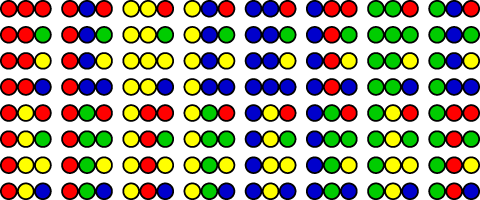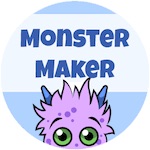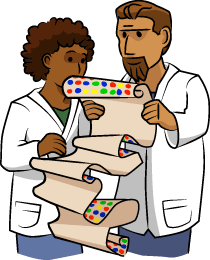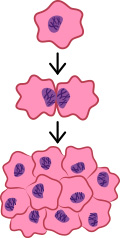How to Build a Monster
By Karla Moeller
Illustrated by Sabine Deviche

If you wanted to build a monster, a plant, or an animal, where would you start? Where do architects start when they are building a house? The best place to start if you are building a house, or any living thing, is with instructions. For a house, this usually comes in the form of a large blueprint that maps out all the rooms, their location, and how much space they each have. For plants, animals, and even monsters, there are teeny, tiny instructions that we call our genetic code that act as our blueprint.
These instructions are held in each cell of every living organism. Cells are the compartments that make up all of the tissues in our body like skin and bones, and most are so small they cannot be seen without a magnifying glass or microscope. If you unravel the DNA in each of these cells, the genetic code can be stretched out to over 6 feet long! Within this strand is all the information required to build and keep an organism alive. These instructions are made of various combinations of only 4 different molecules.
Combinations of Molecules
Molecules are tiny compounds of smaller atoms, which are the smallest units of matter that still act as an element, such as oxygen or carbon. DNA strands are made of long connections of different combinations of 4 molecules, which we can think of as letters or colors. For example, let’s take 2 colors: yellow and red. We will use the letters Y and R to stand for these colors. If you are allowed to make a string of 3 colors, let’s see how many different combinations you can make.

Let’s start with just one color: yellow. What combinations can we make? Only one, right?
The whole thing would have to be yellow, since that’s the only color we have.
What if we add a second color? Let’s add red. Now how many combinations can we make?

So all together, using yellow and red, we already have 8 different combinations we could make.
If we had 3 colors, we could make 27 combinations.

If we had 4 colors, we could make 64 combinations. Each of these combinations gives a unique instruction to the cell.

This table shows how many different orders of combinations you can make with different string lengths and different numbers of colors:

What’s really amazing is how complex these instructions can be, using only 4 different colors. If we put some of these 3-color combinations together, as if we were putting different letters together to make words, we could make even more combinations.
Let’s think again about our 4 colors that can stand for different DNA molecules… red, yellow, blue, and green. These colors could join together like colored beads in a long necklace (or strand), hundreds or thousands of beads long.

One more thing to think about when you are imagining these necklaces is that DNA actually has two strands of colors, or molecules, that are connected, with certain colors almost always sticking together. For example, red would go with yellow, and blue would go with green.
Once we have these long, double strands, we have long sections in them that we call “genes.” A gene is a section of DNA that decides what traits we will have, such as if our eyes will be blue, or what color our hair is. Monster DNA might decide if they have polka-dots on their body, or if they have one or two eyes or horns.

The Monster Game
Now let’s try to understand this idea further by playing a game with monster DNA. In the game, you will see lines of 3 colors of dots, which you will match to sets in the decoding section. For example, the set of 3 colors red-green-blue stands for the capital letter “C”. Once you’ve decoded all the color sets, you can see the words, or genes, that decide what your assigned monster picture will look like.

Scientists Use DNA to Try to Fight Disease
Using computers that can search through the long, long instruction set, or code, that make up human DNA, scientists try to find patterns in the instructions. Most of the time, scientists expect humans to have the same code as each other.
However, even for important traits like the structure of your cells, sometimes a single DNA molecule will be different than it should be, or there can be missing or extra molecules. These are called DNA mutations, which means the DNA is changed. By finding these mistakes in the pattern, scientists may learn what part of the code may be causing problems, such as different diseases, or which instructions may help a person to avoid disease.
Where Your DNA Started
Now that you understand how the same 4 molecules can code for so many different combinations of instructions, where do you think the instructions come from? The two parents of a child or a monster each make special types of cells. Females make what are called eggs, and males make what we call sperm. These two special types of cells, eggs and sperm, each have half of the instructions required for building a body, made of bits of each parents’ own instructions. A female’s eggs have some of her own DNA, and a male’s sperm has some of his DNA.

When the egg joins with sperm, the egg is activated, or fertilized. This joins together the instructions of both the egg and the sperm, to make the new set of DNA for a child. This is why sometimes children have features that look a bit like their mom’s and sometimes they have features that look a bit like their dad’s.

As your first cells grew and split into more and more cells to form your body, the instructions from this activated egg were passed along to each new cell. The instructions would be copied within a cell, and then as that one cell breaks into two different cells, each cell only takes one copy of the instructions.
These instructions are so long, that each cell only ends up using part of them, and this allows us to grow different types of tissue, such as skin, bone, and blood. Just imagine, all the instructions needed to make an entire human or monster are all curled up and packed into a tiny fertilized egg.
Author Karla Moeller earned her PhD in Biology at Arizona State University. She is an animal physiologist, a science writer, and a children's book author.
Read more about: Monster Maker
Bibliographic details:
- Article: How to Build a Monster
- Author(s): Dr. Biology
- Publisher: Arizona State University School of Life Sciences Ask A Biologist
- Site name: ASU - Ask A Biologist
- Date published:
- Date accessed:
- Link: https://askabiologist.asu.edu/build-monster
APA Style
Dr. Biology. (). How to Build a Monster. ASU - Ask A Biologist. Retrieved from https://askabiologist.asu.edu/build-monster
Chicago Manual of Style
Dr. Biology. "How to Build a Monster". ASU - Ask A Biologist. . https://askabiologist.asu.edu/build-monster
Dr. Biology. "How to Build a Monster". ASU - Ask A Biologist. . ASU - Ask A Biologist, Web. https://askabiologist.asu.edu/build-monster
MLA 2017 Style

Be Part of
Ask A Biologist
By volunteering, or simply sending us feedback on the site. Scientists, teachers, writers, illustrators, and translators are all important to the program. If you are interested in helping with the website we have a Volunteers page to get the process started.

